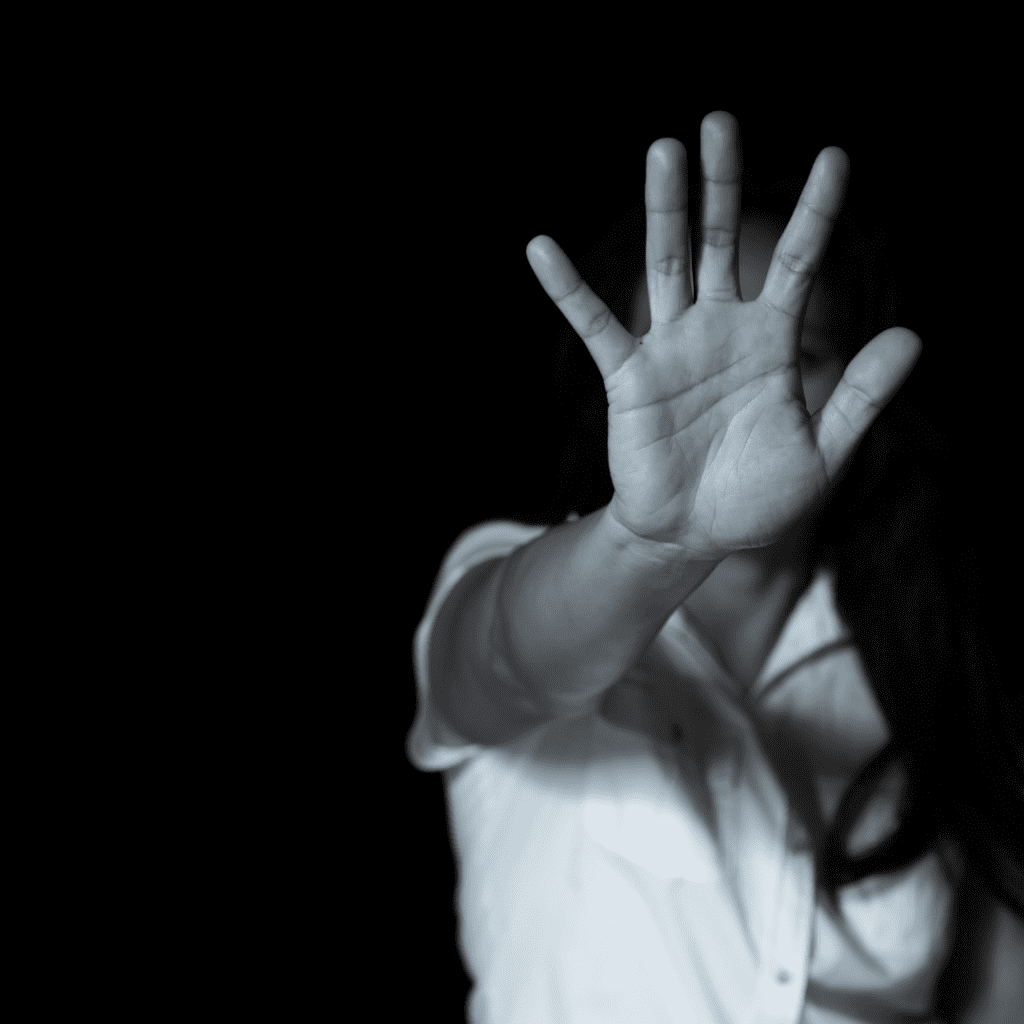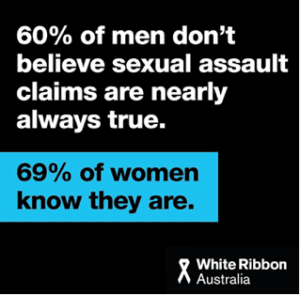Trigger Warning: This article contains themes regarding self-harm, sexual abuse, rape and suicide. Please note there are resources for support listed below.

Around 60% of men don’t believe women’s claims of sexual assault and 69% of women know they’re true. Photo from Canva.
It was an ordinary day and I opened Facebook. Former NRL star Jarryd Hayne had been accused of sexual assault and found guilty. Thousands of comments flooded, mostly by men, some of whom I know:
“What was she doing there with him alone?”
“She should have kept her legs closed, the slut”
“Attention seeker”
I could go on. Even my friends, who identify as women, groan when women accuse football stars of sexual assault. How do we shame victims for speaking up, but act surprised and shocked when they self-harm or end their lives? How have we failed so terribly as a society?

Victim-blaming is one of the biggest obstacles for survivors of sexual assault. Supplied from White Ribbon.
I thought, how would you differentiate between an ‘actual victim’ and an ‘attention seeker?’. While there have previously been false accusations, according to the ABC’s Australia Talks national survey, 60% of men don’t believe women’s claims of sexual assault and 69% of women knowthey’re true.
The truth is, to discuss why I was so triggered – we have to go back. This is my story.
I was a quiet high-school student. Awkward, like most adolescents. However, I had a history of experiencing sexual assault in childhood, so I was especially insecure.
However, when he took me to the woods and forced himself on me until I bled everywhere, my world changed. I remember crying and shaking. I remember time standing still.
Rumours circulated around the school.
“By the way” a male friend said to me once, “it happens to a lot of girls their first time”
“When what happens?” I wondered.
“Getting your period” he responds.
I didn’t have a reaction for a few moments. Then I started to sob uncontrollably. This whole time, there was an army of boys laughing at me that I had bled on a boy. He loved every minute of this torment. Despite telling my story, I am sure this guy didn’t believe me. I’m also sure if any people I went to high school with are reading this now, they wouldn’t believe it either. Attention-seeker. It’s your fault. Where were your parents?
I’ve heard all of these things. I repeated them in my head when I tried to cut myself. When I imagined myself drowning in a bath tub. When I was driving 140km/h hoping to crash. Despite all these bad memories, I have healed and feel comfortable sharing my story in hopes that someone reading this will feel some strength too.
Our rape culture
According to the 2017 National Community Attitudes towards Violence against Women Survey (NCAS), one in eight Australians believe if a woman is raped while intoxicated by alcohol or drugs – she is at least partly responsible. Victim-blaming, in essence, is why women do not come forward until many years later. Yet, when they do, they are challengedwith questions like ‘…why did you take so long to come forward?’. Either way, we cannot win. Especially in court cases where the survivor must be a ‘model victim’ – otherwise, she is ripped to shreds, like in Brittany Higgins’case.

Brittany Higgins & Grace Tame giving speeches at a March4Justice rally in March. Supplied from Junkee.
Because rape is an event highly unimaginable to the average person, feelings of empathy can be projected towards the accused. Especially if they are in the public eye. How could they rape? I know them. We think twice about the accused, but do not do the same for the victims. In 2018, 52,396 sexual assault cases were reported to the police in Australia. Of these cases, only 12,894 charges were laid, 2308 charges of which were dropped and 1494 ruled as not guilty, based on an investigation by The Age.
Approaching survivors of sexual assault
So, what can we do?
We need to build our society on acceptance. Even when I went to the Deputy Principal about my situation, she said to leave her office and claimed it wasn’t her responsibility, considering it happened off school grounds. Our system is designed to inherently benefit men.
For service providers, it is important to have female employees or officers on duty and have them interact with the survivor, as recommended in a 2018 Journal of Aggression, Maltreatment and Trauma. These providers should also be able to break down legal implications and jargon to the survivor, especially to those coming from a minority.
For us, the responsibility is less. We just need to listen. Believing and not blaming our survivors is first and foremost. Approach trauma sensitively with caution and care. This is something I learnt in class, and I’ll never forget: regardless of your beliefs or religion, it is our human duty to help one another.
How can we educate ourselves?
Rape culture is an issue on a widespread level. It requires a deep un-learning of social behaviours. A book I highly recommend is See What You Made Me Do by Jess Hill.It focuses on the need for educating our men, not women. It also opens up a new world of understanding patriarchy and how the system in our current society is designed to supress women. As American sociologist Michael Kimmel states, “I explain patriarchy as a dual system of power: men’s power over women, and some men’s power over other men.”
“As a group, men are dominant and privileged in relation to women. But as individuals, men pay a price for this privilege: to be considered ‘real men’, they have to live up to patriarchy’s standards and abide by its rules. These standards and rules are regulated – through fear, control and violence – by other men,” says Dr. Michael Kimmel.
This kind of culture is where women are seen as men’s property. According to the National Coalition Against Domestic Violence, at least 1 in 10 women will experience marital rape. However, this is extremely difficult to contest in court and nearly impossible to even comprehend as rape from the victim’s perspective. How can a man that she (or he) has been married to for years, and loved, do this to them?
It’s this kind of culture where men need to take a step back and reflect on their actions. Call out your mates. Reflect on your past and your actions. Shame is a massive aspect in the misogynistic behaviour of young men, dwelling from the pressures and standards society puts on them. We shouldn’t blame our men, but heal them.
I’m going to leave you with a quote from Steve Jobs, that my dear friend Tasha reminds me of: “The ones who are crazy enough to think they can change the world, are the ones that do.”
Support services
Western Sydney University free and confidential counselling service support:
1300 668 370(option 4 then option 1)
Lifeline
13 11 14
National sexual assault, domestic family violence support
1800 737 732 – 1800RESPECT
NSW Health Sexual Assault Services
Provides free and confidential medical and counselling support to anyone in NSW who has experienced sexual support, and their non-offending supporters.



